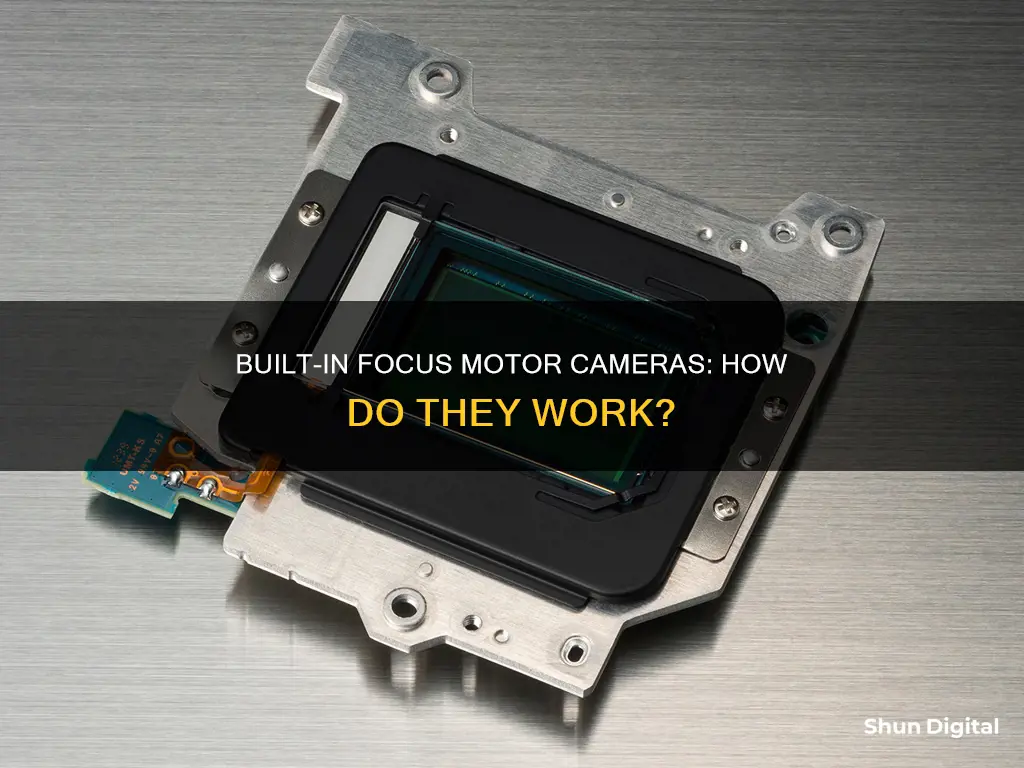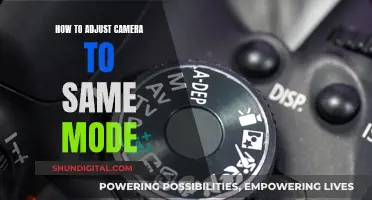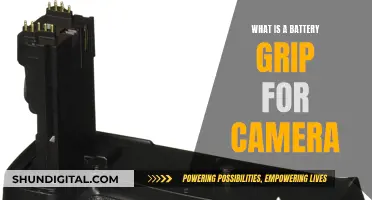
Autofocus is a feature of modern cameras that automatically adjusts the lens to focus on a desired subject. In order for autofocus to work, either the camera or the lens must have a built-in autofocus motor. A built-in focus motor in a camera is a small electric or piezoelectric (ultrasonic) motor that moves the lens elements to facilitate autofocus. This autofocus motor can be found in the camera body or the lens itself.
The autofocus motor is responsible for driving the lens elements to change focus, ensuring that the lens elements move and align to put the object in focus. This results in sharp and clear photographs, as the camera system can automatically adjust the lens to the correct position without manual intervention.
| Characteristics | Values |
|---|---|
| Purpose | To adjust the lens to bring the desired subject into focus |
| Function | Moves the lens elements to change focus |
| Focus | Can be automatic or manual |
| Manual Focus | Requires turning a ring or similar mechanism on the lens |
| Autofocus Motor | Can be in the camera body or the lens |
| Autofocus Types | Phase detection, contrast detection, continuous-servo, single-servo |
| Autofocus Performance | Speed, accuracy, noise level, compatibility, reliability |
| Autofocus Motors | Micro, DC, Ultrasonic (USM), Silent Wave (SWM), Linear, Stepping (STM), Nano USM |
What You'll Learn
- Autofocus motors can be built into the camera or the lens
- Autofocus motors can be electric or piezoelectric
- Autofocus is achieved by moving the lens elements
- Autofocus can be activated by pressing a button or half-pressing the shutter button
- Autofocus motors can be ultrasonic, silent wave, linear, or stepping

Autofocus motors can be built into the camera or the lens
Autofocus motors can be built into the camera body or the lens. When you press the shutter button halfway to focus, a motor in the camera or lens moves and aligns the lens elements to focus on the object. This is called autofocus, and it can be achieved through several types of autofocus motors.
In some camera systems, the autofocus motor is in the camera body, and the lens is moved by a physical coupling. However, some camera models, such as Canon EOS cameras, have autofocus motors built into the lenses, not the camera body.
The type of autofocus motor varies depending on the lens manufacturer, lens type, and price range. Basic autofocus motors consist of small electric motors that move the lens elements to achieve focus. More advanced autofocus motors, like ultrasonic motors (USM), use ultrasonic vibrations to drive the focusing elements, resulting in faster, accurate, and nearly silent autofocus operation.
When purchasing a camera or lens, it is important to ensure that at least one of them has an autofocus motor to utilise the autofocus function.
Editing Color Negatives: Camera Raw Techniques
You may want to see also

Autofocus motors can be electric or piezoelectric
An autofocus motor is a small device that moves the lens elements to facilitate autofocus. In some camera systems, the autofocus motor is located in the camera body, while in others, it is built into the lens itself. For example, Canon EOS cameras have autofocus motors in their lenses, whereas Pentax cameras have them in the camera body.
Piezoelectric motors are a type of electric motor that uses the piezoelectric effect for motion generation. The piezoelectric effect is observed in certain materials, mainly crystals and ceramics, which generate an electric charge when subjected to mechanical stress. These materials also exhibit mechanical deformation when an electric field is applied. Piezoelectric motors exploit this reversible effect to convert electrical energy into mechanical motion or vice versa.
There are several types of piezoelectric motors, including linear, rotary, and ultrasonic piezoelectric motors. Linear piezoelectric motors generate linear motion by applying an alternating voltage to a piezoelectric element, causing it to expand and contract. Rotary piezoelectric motors use the piezoelectric effect to induce a twisting or bending motion in a piezoelectric element. Ultrasonic piezoelectric motors use high-frequency vibrations generated by piezoelectric elements to create motion.
Piezoelectric motors offer several advantages over traditional electromagnetic motors. They provide precision and resolution at the nanometer level, making them ideal for applications such as microscopy and nanotechnology. They also have a fast response due to the direct coupling between the electrical input and mechanical output, enabling quicker acceleration and deceleration. Additionally, piezoelectric motors are energy-efficient, compact, and lightweight, making them suitable for various applications, including autofocus systems in cameras.
Mastering Focus-Pulling: Tips for Camera Assistants
You may want to see also

Autofocus is achieved by moving the lens elements
Autofocus (AF) is a feature in cameras that automatically adjusts the focus of the lens to ensure the subject is sharp and in focus. This is achieved by moving the lens elements, which are the glass elements inside the lens that can move forward and backward to change the optical path of light. The autofocus motor can be found in either the camera or the lens, and sometimes in both.
The autofocus system uses a motor to focus on a subject that has been selected manually or automatically. The process of autofocusing generally involves an autofocus processor (AFP) making small changes to the focusing distance, reading the AF sensor to assess whether and by how much focus has improved, and then setting the lens to a new focusing distance. This process may be repeated until the camera achieves satisfactory focus.
There are several types of autofocus mechanisms, including contrast detection, phase detection, and hybrid autofocus. Contrast detection autofocus works by analyzing the contrast in the image and adjusting the focus until the contrast is maximized. Phase detection autofocus, on the other hand, works by splitting the incoming light into two images and comparing the phase difference between them. Hybrid autofocus combines both contrast detection and phase detection autofocus to achieve faster and more accurate focusing.
The introduction of autofocus technology in the early 1980s transformed photography by making it more accessible to both amateur and professional photographers. With autofocus, photographers can capture sharp images quickly and efficiently, even when capturing moving subjects.
Focusing the Mobius Camera: Tips and Tricks
You may want to see also

Autofocus can be activated by pressing a button or half-pressing the shutter button
Autofocus, or AF, is a comparatively new invention in the history of photography, first appearing on the market in 1977. Today, it is a standard feature in most cameras. In essence, autofocus is when the camera system drives a motor to move elements in your lens to change focus.
Most cameras will activate the autofocus function when the shutter button is pressed halfway down in the default settings. However, some photographers prefer to separate the autofocus function from the shutter button and assign it to a different button, usually one on the rear side of the camera. This is often referred to as "Back Button AF".
By default, most cameras will autofocus when you half-press the shutter button. This is a nice feature, but there are times when you will want the two actions – focusing and taking a photo – to be separate from one another. For example, if you want to lock focus across several photos, or if you want to focus and recompose. In these cases, you can assign focus to a different button, often called AF-On, and remove it from the shutter release button.
Some cameras also allow you to activate autofocus by pressing a custom button defined by the photographer. This can be useful in situations where you want to engage the autofocus operation on demand or instantly take a picture without the autofocus function, which may interfere with your composition or change the pre-set shooting distance setting.
The Evolution of Cameras: Components and Advancements
You may want to see also

Autofocus motors can be ultrasonic, silent wave, linear, or stepping
Autofocus motors are an essential component of modern cameras, allowing for quick and accurate focus adjustments. These motors can be ultrasonic, silent wave, linear, or stepping, each offering unique advantages and suited to specific photography needs.
Ultrasonic motors, as the name suggests, utilise ultrasonic vibrations to drive the focusing elements in a camera lens. They are known for their fast, accurate, and nearly silent operation, making them ideal for sports, wildlife, and action photography. Canon pioneered the use of ultrasonic motors in the late 1980s, incorporating them into their autofocus lenses.
Silent wave motors, commonly found in Nikon lenses, offer similar benefits to ultrasonic motors. They provide fast, silent, smooth, and precise autofocus performance, making them suitable for a wide range of photography genres, including wildlife and portraiture. Silent wave motors use electromagnetic waves to drive the focusing elements, resulting in a quiet and efficient autofocus system.
Linear motors are often used in lenses designed for mirrorless cameras. They employ electromagnetic fields to move the focusing elements along a straight path, enabling high-speed focusing and precise control. This type of motor is particularly useful for video recording due to its quiet operation and ability to provide improved tracking and subject detection in continuous autofocus modes.
Stepping motors are commonly found in mirrorless lenses, especially those designed for video shooting. They offer silent, precise, and gradual adjustments of focus, ensuring smooth focus transitions during autofocus. While they may be slower in certain scenarios, they excel in providing uninterrupted autofocus performance for video recording.
The variety of autofocus motors available allows photographers to choose the right equipment for their specific needs. Whether it's the speed and accuracy of ultrasonic or linear motors or the silent precision of silent wave and stepping motors, these technologies have revolutionised photography, making it easier and more efficient to capture sharp and focused images.
Olympus Cameras: Crafted in the Heart of Japan
You may want to see also
Frequently asked questions
A built-in focus motor camera has a motor in the camera body that moves the lens elements to achieve autofocus.
When you press a button on your camera, it will focus on your chosen subject – or choose one for you if you prefer. The camera system drives a motor to move elements in your lens to change focus.
Most photographers use autofocus more often than manual focus. Autofocus is more convenient, faster, and more accurate.







